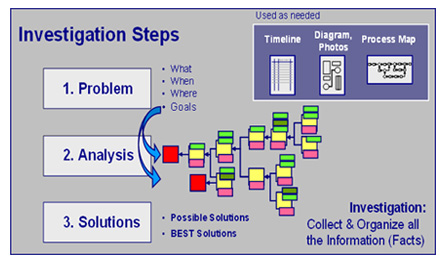Step #1: What’s the problem? (the definition)
 Everyone seems to know that defining the problem is the first step in an investigation. How this is done varies widely. Some groups write a lengthy problem statement and then debate the wording for 30 minutes or more. A facilitator should remember that people see problems differently. When someone states his/her view of the problem, be prepared for the fact that someone else is going to disagree and offer a different problem. The word “problem” itself is problematic, in that people use it for whatever they see as the “bad thing.” To accurately define a failure, there are four more simple questions answer: Everyone seems to know that defining the problem is the first step in an investigation. How this is done varies widely. Some groups write a lengthy problem statement and then debate the wording for 30 minutes or more. A facilitator should remember that people see problems differently. When someone states his/her view of the problem, be prepared for the fact that someone else is going to disagree and offer a different problem. The word “problem” itself is problematic, in that people use it for whatever they see as the “bad thing.” To accurately define a failure, there are four more simple questions answer:
- What’s the problem?
- When did it happen?
- Where did it happen?
- How were the overall goals impacted?
Instead of writing a long problem description, simply answer these four questions in an outline format--and don’t write responses as complete sentences, just short phrases.
The question, “How were the overall goals impacted?” captures the overall magnitude of any issue. While the first question--“What’s the problem?”—reflects individual views of the problem, the company is going to view the problem as any deviation from the ideal state. For a manufacturing company, the overall goals (or ideal states) typically include: no safety injuries, no environmental issues, no customer service issues, no production problems and no excess materials or labor spending.
The overall goals that were negatively impacted by a failure incident provide the starting point for the “why” questions. Step #2 does not start with what people see as “the problem,” rather, it begins with the impact to the overall goals (the 4th question). People see problems differently, but defining every failure by how it negatively impacts the goals provides a consistent starting point. Start with the impact to the overall goals to define your next problem.
|